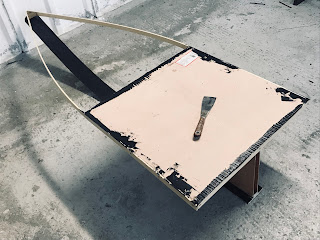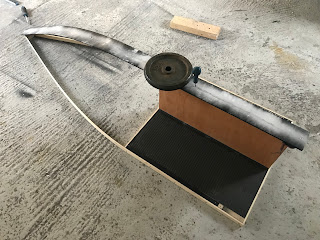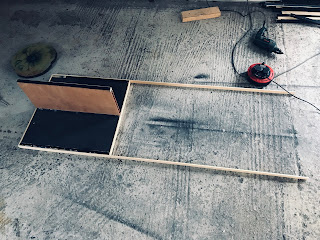Okay, just one more but then it's bedtime, right?
I happened upon Captain Steeeve's YouTube channel by a bot called chance, though normally tune in to either Pilot Debrief in the US or Mentour Pilot (stet) in Europe as and when the fancy takes me. The eminently qualified Hoover who hosts the former has thrown his own hat in the ring as regards Air India's 787 and slides all his chips onto a square marked 'shut off the wrong engine'.
Hoover surmises that they may have lost an engine on take-off, in which aftermath the good engine was shut down by mistake. Combined with the drag of an extended gear, this would account for a gradual reversal of the climb rate, especially should the failed engine still be producing an element of thrust.
A few things are worth examining, based upon the hundreds of assessments I have either observed or performed myself with regard to executing the drills required for an engine failure on take-off (EFATO... we loved our acronyms).
Firstly, the GEAR is often forgotten in the excitement. If you've been in a car crash you will know the feeling of life going by like a projection on a screen before being interrupted by a jarring sensation that what is happening cannot possibly be. I've rejected a take-off at 150 m.p.h. and despite seeing the birds disappear beneath the flight deck and suspecting they were destined for the engine, could not quite believe it when it happened.
Best you can hope for is that at some stage one or other pilot twigs the gear is the reason the aircraft is still not climbing away on one engine.
Second, there is a huge element of DISTRACTION from drills in so far as the pilot doing the flying is wholly concentrated on staying airborne, monitoring drills being a side hustle that you get better at only after many years and constant iteration.
I knew of a 737 flight-test where in plain sight a co-pilot disconnected the electrical generators instead of hydraulic flight controls; and a simulator exercise when they pulled both fire handles instead of deploying both fire bottles, the simulated aircraft descending into terrain with 'flying' urging 'non-flying' to review everything they'd done. At times of stress, you miss the obvious.
Third, our brains are wired in two halves, causing left-right CONFUSION. One of the founders of the study of 'human factors' in flying was David Beatty, and his interest was triggered during WW2 when bombers were ferried 'line astern' to North Africa via the Bay of Biscay. They needed to fly south until, near Gibraltar, they'd only to turn left. The aircraft ahead of him turned right, and was never seen again.
In fact I was six years with the same airline at Heathrow, flying the same route in the same type of aircraft that landed on the M6 motorway after the 'good' engine in place of the 'bad' engine was shut down; if they not been able to restart the former then they would have come down a long way short of even the M6, close to the final stages of the approach.
There's a fourth factor though that goes largely unrecognised, and that the urgency with which the orthodoxy requires an engine with any sort of failure to be shut down and indeed after the East Midlands accident many of the older heads I worked with at Gatwick ~ many trained by the military ~ expressed the opinion that they would rather leave an engine producing any level of performance running.
The training orthodoxy is lost in the mists of time, but challenge it and you'd be out the door with no way back. Aviation like all businesses is corrupt, and a way for bad training captains to maintain their status is to cast unorthodox views as heresy, using 'human factors' to convince the hierarchy you're not the right stuff.
Now with the 'gate closed' however we've the leisure to reflect. Firstly, the training methodology which spread globally stemmed from where most flying took place and from manufacturers: UK, Germany and France in Europe, beside the US. Secondly, airliners started life with a motor in front of the cockpit or else fixed to the spar that supported the wings... and thirdly, they'd fail or catch fire relatively often.
All of this meant that fire drills would require engines to be shut down soonest, fire or not. When jet engines were introduced things were no better, as they were often embedded even closer in the airframe. A feature of the Concorde's demise was the flight engineer had the authority to shut down either engine on fire on the left wing, even should the captain had preferred to keep them running (I believe), but with a re-heated engine so close to the fuel, who'd blame the guy?
Then Boeing discovered that a podded engine strung below the wing made sense if only because it actually unloaded the wing ~ if you pitched weight forward there was less 'flutter' and wings could be made lighter ~ beside making maintenance a whole lot quicker. Meantimes the fire issue and the orthodoxy remained in place and for good reason... I saw with my own eyes a Boeing 707 that afterward departed Heathrow with an engine fire and returned to land on the (then) crosswind runway, apparently only minutes from the fire burning through the wing-spar.
Then things changed, but as with much in life including the internet it takes longer for people to adapt than it does the tech. The likes of GE and RR, boosted by wars in the Middle East and accompanying fuel crises, developed the turbo-fan and what is now considered a jet engine is better considered a jet engine driving a very large fan. So large in fact that those on the 777 are wider than the cabin of the 737 on whose flight deck it was largely based... you can fly both with the extra training.
Now what happened, as again I've seen with my own eyes but via the all-pervasive video footage, was airliners like the Airbus 300 might fly with an unconfined engine fire for the 20-30 minutes required to find a place to land. A reason for this was precisely that growth in the size of engines, and advances in the design and build of landing gear to support it on the ground. Things were better than they seemed, too, because the root cause of many fires is likely to centre on the core of the jet, which was now centred even further from the wing.
Though we've still circs where training overwhelmingly focuses on engine failures on departure, that was starting to change as I was beginning to leave. One reason for the spotlight to move, incidentally, is the increasing automation of airliners, so that for instance 'swing' due engine failure (much like a blow-out in a car) is effectively eliminated in aircraft like the 787.
Why then a rush to extinguish engines without ~ or even with ~ fire at the get-go, given the shock, stress, confusion and distraction which flesh is heir to? And given three-quarters of all accidents are attributable to pilot error? And pending the day when AI will surely intervene like the mainframe in 2001 to say, No Dave, I can't do that?
What Hoover is saying, in conclusion, is that given both engines failing were a cause for the RAT to deploy, the most likely reason (given a choice of fuel contamination, bird-strike or pilot error) is statistically the latter. And who'd gainsay that? He points out no-one else has posited it as a likely cause, and likewise no-one outside these pages has suggested electrical glitches might have commanded the same thing... though were I playing poker with Hoover I'd probably fold.
Why the pic, though? The 737 was maybe the only airliner to have been successfully adapted to carry the much larger turbo-fan engine in place of the original fighter-jet engine in the shape of the JT8-D. It left so little ground clearance that the profile could no longer remain round, and pilot notes highlighted the chances of ground contact during landing and take-off. It's failures forced two aircraft that I know of into forced landings ~ one fatal and one not ~ but it went on to be the most reliable engine ever and a perfect marriage of French and American expertise.
Flight training is much like the Catholic Church, the same observances and uniforms required worldwide. I've worked for different airlines around the world, where rites and rituals remain the same. One anomaly is that even should there be a vast length of runway remaining, 'V-speed' rules developed in the UK might require the problem to be taken into the air. When a Chinese captain was punished in Shanghai (along with the whole class) for re-landing an empty airliner following a bird-strike, I was alone in defending him... a Sukhoi-27 jock, excellent trainer and a good egg.




































